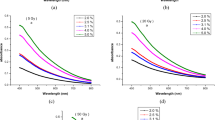Summary
Melanosomes and isolated melanosomal fragments (melanin particles) originating from gangliocytes (substantia nigra), astroglia (melanosis cerebelli), and melanocytes (melanotic meningeoma; metastases of melanoblastoma; melanosis thalami of the goat) were compared with synthetic melanins prepared from dopamine and serotonin, respectively. Samples were examined by electron microscopy, X-ray diffraction analysis according to Debye-Scherrer and by infrared spectrophotometry, and the results were evaluated with regard to characteristic features as they may relate to specific cell types or chemical structures.
On electron microscopy all three types of melanosomes could be differentiated unequivocally as could the two synthetic melanins. Thus, there were similarities between synthetic melanin from dopamine and the gliogenic melanins of the cerebellum; the synthetic melanin from serotonin resembled melanin of melanocytes.
X-ray diffraction analysis yielded 2-4 Debye diffraction rings with all human and synthetic samples, suggesting short range orders between 3.8 to 5 Å the sample obtained from a goat with thalamic melanosis showed a specific reflex pattern. While diffraction patterns of some melanins were partially identical, in particular that of melanin from dopamine and melanin of substantia nigra and dentate nucleus, respectively, they were different for the various melanocytic melanins. Further investigations are required to determine whether these differences are due to disparities in basic chemical structures or conformations or else, to particular compositional features of the various types of melanocytes as they arise from benign or malignant tumors or a specific species.
Infrared spectrophotometry at higher wave numbers revealed the well known patterns of melanins, which are not, however, very suitable, for their further differentiation. At lower wave numbers (‘fingerprinting’) melanin of substantia nigra and the glial melanin in melanosis cerebelli yielded additional absorption bands of identical configuration. In contrast to melanin from dopamine, melanin from serotonin exhibited a closely similar absorption pattern in this spectral range, suggesting that the neuroectodermal melanins may contain a component possibly arising from serotonin.
Similar content being viewed by others
Literatur
Bestetti, G.: Die Thalamusmelanose der Ziege: Elektronenmikroskopische Aspekte. 28. Tg. d. Europäischen Ges. f. Veterinärpathologie, Stuttgart, 4.–5. Juni 1979
Boesel, C. P., Suhan, J. P., Sayers, M. P.: Melanotic medulloblastoma. J. Neuropathol. Exp. Neurol.37, 531–543 (1978)
Bonner, T. G., Duncan, A.: Infra-redspectra of some melanins. Nature184, 1078–1079 (1962)
Borit, A.: The striato-nigral form of parkinsonism. VIIth International Congress of Neuropathology, Budapest, 1974
Borit, A., The Rubinstein, L. J., Urich, H.: The striato-nigral degenerations: Putaminal pigments and nosology. Brain98, 101–112 (1975)
Budka, H.: Primäre umschriebene Melanome des ZNS. In: Aktuelle Probleme der Neuropathologie. Facultes Wien 1973
D'Agostino, A., Luse, S. A.: Electron microscopic observations on the human substantia nigra. Neurology (Minneap.)14, 529–536 (1964)
Das, K. C., Abramson, N. B., Katzman, R.: Neuronal pigments: Spectroscopic characterization of human brain melanin. J. Neurochem.30, 601–606 (1978)
Diezel, P. B.: Die Stoffwechselstörungen der Spingolipoide. S. 113–115. Berlin, Göttingen, Heidelberg: Springer 1957
Fankhauser, R.: Cerebrale Melanose bei der Ziege. Wien. Tierärztl. Monatsschr.4, 373–384 (1963)
Fatzer, R.: Die Thalamusmelanose der Ziege: Makroskopische und lichtmikroskopische Aspekte. 28. Tg. d. Europäischen Ges. f. Veterinärpathologie. Stuttgart, 4.–5. Juni 1979
Friede, R. L.: Striato-nigral astrocytic melanization. J. Neurol.220, 149–165 (1979)
Kaliner, G., Frese, K., Fatzer, R., Fankhauser, R.: Thalamic melanosis in goats. Schweiz. Arch. Tierheilkd.116, 405–411 (1974)
Limas, C., Tio, F. O.: Meningeal melanocytoma. Cancer30, 1286–1294 (1972)
Marsden, C. D.: Brain melanin. In: Wolman, M. (ed.), Pigments in pathology, p. 395. London, New York: Academic Press 1969
Moses, H. L., Ganote, Ch. I., Beaver, D. L., Schuffman, Sh. S.: Light and electron microscopic studies of pigment in human and Rhesus monkey substantia nigra and locus ceruleus. Anat. Rec.155, 167–184 (1966)
Moyer, F. H.: Genetic effects of melanosome fine structure and ontogeny in normal and malignant cells. Ann. NY Acad. Sci.100, 584–606 (1963)
Prota, G., Thomson, R. H.: Melanin-Pigmentierungen in Säugetieren. Endeavour35, 32–38 (1976)
Russel, D. S., Rubinstein, L. J.: Pathology of tumours of the nervous system. London: Arnold 1971
Scherer, H. J.: Vergleichende Pathologie des Nervensystems der Säugetiere. Leipzig: Thieme 1944
Seiji, M., Shimao, K., Birbeck, M. S. C., Fitzpatrick, T. B.: Subcellular localization of melanin biosynthesis. Ann. NY Acad. Sci.100, 497–533 (1963)
Spatz, H.: Physiologie und Pathologie der Stammganglien. In: Handbuch der normalen und pathologischen Physiologie, Bethe, A., Bergmann, G. von, et al., Bd. 10, S. 318, 1927
Thathachari, Y. T.: X-ray diffraction studies on melanins. J. Invest. Dermatol.54, 99 (1970)
Ule, G., Berlet, H., Haag, D., Riedl, H.: Ein bisher kaum bekanntes gliogenes Melanin des Gehirns (“Cerebellares Gliamelanin”). Virchows Arch. [Pathol. Anat]380, 335–339 (1978)
Ule, G., Berlet, H.: Melanosis cerebelli. Acta Neuropathol. (Berl.)46, 215–220 (1979)
Woert, M. H., van, Parasp, K. N., Borg, B. C.: Spectroscopic studies of substantia nigra pigment in human subjects. J. Neurochem.14, 707–716 (1967)
Wellings, S. R., Siegel, B. J.: Electron microscopic studies on the subcellular origin and ultrastructure of melanin granules mammalian melanomas. Ann. NY Acad. Sci.100, 548–568 (1963)
Zülch, K. J.: Die Hirngeschwülste in biologischer und morphologischer Darstellung. 2. Aufl Leipzig: Barth 1956
Author information
Authors and Affiliations
Additional information
Herrn Prof. Dr. Wilhelm Doerr zum 25. 8. 1979
Rights and permissions
About this article
Cite this article
Ule, G., Berlet, H., Riedl, H. et al. Über Melanin und Melanosomen im ZNS im Vergleich zu extracerebralen Erscheinungsformen und synthetischem Melanin aus Dopamin und Serotonin. Acta Neuropathol 48, 177–188 (1979). https://doi.org/10.1007/BF00690518
Received:
Accepted:
Issue Date:
DOI: https://doi.org/10.1007/BF00690518



